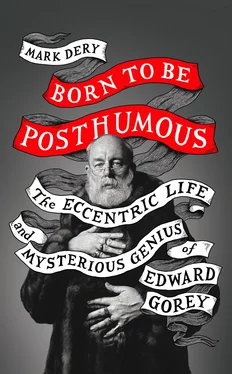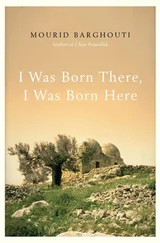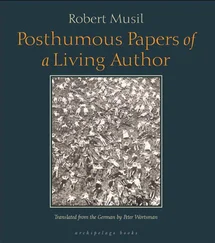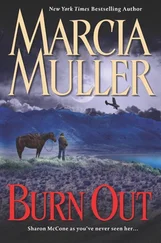In his little books, Gorey would, like the surrealists, the French avant-gardists known as the Oulipo group, and Victorian writers of nonsense verse such as Lear and Lewis Carroll, privilege formal experimentation over conventional storytelling (although he did believe in the importance of plot). Rather than the psychologically three-dimensional characters we meet in mainstream fiction, he preferred the stock types and mythic archetypes familiar from silent films and ballets, folktales and fairy tales, Kabuki and Noh theater, whodunits and penny dreadfuls.
This doesn’t mean his work was divorced from lived experience: surrealism, aestheticism, and nonsense are no less capable than realism of accessing the deeper truths of the human condition. Brad Gooch’s analysis of O’Hara applies equally to Gorey: “He didn’t want to be a Hemingway, the sort of popular writer who reduced the complexities of felt life to an ‘elegant machinery’ while his characters pretended to a deceptive lifelikeness.” Instead, as O’Hara put it, he wanted “to move towards a complexity which makes life within the work and which does not (necessarily, although it may) resemble life as much as most people think it is lived.” 60
After Harvard, Gorey would never again attempt long-form fiction. He would invent a genre all his own, one that partook of the illustrated children’s book, the mystery story, the graphic novel (Gorey anticipated the genre decades before Art Spiegelman’s Maus popularized it, in 1986), the artist’s book (conceptual artwork in book form), and tongue-in-cheek treatments of moralizing nursery rhymes (Heinrich Hoff-mann’s grisly-funny Struwwelpeter and Hilaire Belloc’s Cautionary Tales for Children are the most obvious influences). His little books don’t fit neatly into any category but Gorey, really. Yet they’re inarguably a species of fiction, however uncategorizable, and Gorey would always think of himself as “first a writer, then an artist.” 61
By the spring of ’49, O’Hara had gotten so tight with another Eliot House resident, Hal Fondren, that he was spending much of his time in O-22, Fondren’s suite, which looked out on the housemaster’s garden. A fellow vet who’d served as an air force gunner in England, Fondren was witty and cultured in the usual Anglophilic way: he liked to show off his collection of the early pamphlet editions of T. S. Eliot’s Four Quartets , which he’d purchased as they came out, one by one.
Speaking of quartets, Gorey struck up a friendship with Fondren’s roommate, Tony Smith. Smith, the scion of a wealthy Republican family, was an econ major who’d prepared at ultraexclusive Exeter. He doesn’t seem like Gorey’s type, but, against all odds, they began palling around.
Gorey and O’Hara were growing apart, partly as a result of O’Hara’s absorption in Fondren and partly because their diverging creative trajectories and social styles were accentuating their differences. O’Hara’s appetite for intellectual blood sports—cocktail-party games of oneupmanship—and his hard-partying, hard-drinking gregariousness contrasted sharply with Gorey’s reclusiveness and dry, ironic style. “Gorey’s style was never entirely appropriate for O’Hara,” notes Gooch. 62“As a schoolmate put it, Gorey’s style was ‘cool, English. Nothing could get to you. But then Frank was someone who everything got to.’” 63Even so, Gorey continued to serve as a model of unapologetic individuality for O’Hara, especially in his flamboyant manner and dress, a style later characterized by an obituary writer as “dandy nerd.” 64
The Gorey beard made its first appearance around this time. *Gorey later claimed, in an unpublished interview with a young fan named Faith Elliott, that he let his whiskers grow long to conceal the fact that he had a receding chin, “which is one of the things that’s a deep, dark secret.” 65“If you pushed his beard, for a long face he had a very small chin,” Mel Schierman, his friend from the New York City Ballet scene, confirms. “He made me do it one time.” (In one of her letters to Ted at Harvard, Helen Gorey, ever helpful, enclosed a clipping of a magazine humor column quoting a “physiologist” who reassures weak-chinned readers that “a receding chin does not indicate weakness—either mental or physical.”) 66
Of course, if Ted’s beard was a disguise for the shameful secret that he was a chinless wonder, it did double duty as a token of his affection for Wildean aestheticism, Edwardian dandyism, and nineteenth-century litterateurs like Edward Lear, who sported a majestic beard that’s a dead ringer for Gorey’s. An attraction to the beard as an emblem of Victorian manliness may be somewhere in there, too: Gorey’s fiction, as far back as Harvard, is full of strapping chaps with luxuriant facial hair. Then, too, beards are masks, tailor-made for concealing your true self if you’re the shy, reserved type.
The sneakers and the flowing coat, both as much a part of the Gorey look as his beard, were de rigueur by this time as well, though the coat wasn’t yet the floor-length fur version that would later inspire dropped jaws on Fifth Avenue in Manhattan. “Tony [Smith] and Ted would go shopping every week at [the Boston department store] Filene’s Basement,” Fondren recalled. “It was just at the time when those long canvas coats with sheepskin collars became very fashionable and they both wore them.” 67
Gorey may have borrowed the idea for his famous fur coat from the poet John Wheelwright (Harvard class of ’20), an improbable mix of bohemian and Boston Brahmin who flew the flag of his nonconformity in the form of a floor-sweeping raccoon coat. But it’s just as likely that he lifted the idea from Oscar Wilde, who in some portraits cuts a glamorous figure in his beloved fur coat. Certainly Gorey’s habit, as a freshman, of wearing his hair “plastered down across the front like bangs, like a Roman emperor,” as George Montgomery described it, sounds an awful lot like Wilde in the 1883 Sarony picture of him wearing his hair cut short, with a little fringe of a bang. 68
As for the three-inch-long fingernail that caught Larry Osgood’s eye, it’s useful to know that Firbank wore his nails “long and polished,” according to one of his biographers, “and what was unusual in a man is that they were stained a deep carmine.” 69When we learn that Firbank wore exotic rings on his pale fingers—jade rings from China, Egyptian rings made of blue ceramic—we can’t help wondering if Gorey’s signature rings were, in a sense, Firbank’s.
Gorey’s own explanation, when asked about the origins of his image in a 1978 interview, was predictably scattershot. “The thing is, my drawing tends to be rather Victorian and everything,” he said, and “when I first got [fur] coats, they looked like … they were Victorian, you know, period pieces. (Now they don’t, because other people are going for them.) … I’ve always worn a lot of jewelry, which nobody ever did … and I’ve had a beard for twenty-eight years … and when I first had it everybody said, ‘Do you belong to the House of David or something?’” 70
O’Hara would never be the screwball dandy Gorey was; still, he was taken with Gorey’s independence of mind, manifest not only in his flamboyant dress but also in an intellectual curiosity that followed its own inscrutable logic and in a literary voice that was immune to prevailing trends and critical orthodoxies. In their sophomore year, Gorey and O’Hara favored the Grolier Book Shop on Plympton Street, rummaging through tall shelves stuffed mostly with literary fiction and poetry or reading on the comfily dilapidated sofa that dominated the small but high-ceilinged shop. O’Hara was on a C. Day-Lewis jag, collecting all his novels, which to Gorey’s mind were “sort of elegant, a little dull, concerning sensitive young English men in the early thirties.” 71Gorey was smitten with Ivy Compton-Burnett and was collecting the Penguin editions of her novels.
Читать дальше












